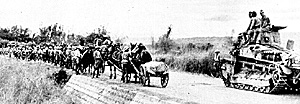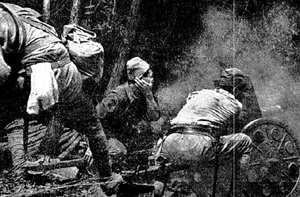
Between May and September 1939, the Kwantung Army fought a pitched battle in the barren wastes along the ill-defined border of Soviet-controlled Mongolia and Manchuria.
After an incursion by Mongolian cavalry into the area claimed by the Japanese, the Kwantung Army assigned forces of the 23rd Division to expel the invaders. This was done in May, but when the Soviets returned in greater numbers, the 23,d Division dispatched a larger force to finish the job. The regimental-sized attack was stalled by the Soviets, leading both sides to heavily reinforce their units committed to the area.
For the Soviets, General Georgy Zhukov was appointed commander in early June. His immediate demands for considerable reinforcements were quickly met. The Kwantung Army in turn committed a large percentage of its available resources. Reinforcing the 23rdDivision was a regiment of the 7th Division, the only two tank regiments in Manchuria, a field artillery regiment, and assorted border guard and Manchuokuan units; all together, there were approximately 20,000 men, 80 tanks, and 112 artillery pieces. By July, the Soviets had committed a motorized rifle division (less one regiment), a tank brigade, three mechanized brigades equipped with armored cars), an part of a rifle division.
On 2 July, the Japanese launched their attack. Their plan was not only audacious, but overly complex. Three regiments of infantry would cross to the west side of the Halha River (or Khalkhin-Gol) to take the Soviets from the rear. Meanwhile, the two tank regiments with another infantry regiment would launch a frontal attack to crush the Soviets. However, after an uncontested crossing of the river, the battle would go badly for the Japanese.
Once across the river, a Soviet tank and a mechanized brigade set upon the infantry regiments. After fierce fighting between the Japanese infantry and Soviet armor, during which the Soviet 1st Tank Brigade lost 62% of its tanks, the Japanese were forced to retreat across the river by 5 July. The frontal assault fared even worse. Soviet artillery broke up the infantry attacks and the tank attack was uncoordinated and resulted in few permanent gains. Finally, the Japanese resorted to night attacks to escape the brunt of Soviet artillery.
From the night of 7/8 July through the night of 12/13 July, the Japanese launched a series of these night assaults and methodically ground their way forward. However, by 12 July the Japanese halted their attempt to eject the Soviets from the disputed area. The withdrawal of the two tank regiments on 10 July (after they had suffered approximately 40% losses) made it difficult for the Japanese to hold their gains during the day against Soviet armored attacks. But the biggest problem was the continual pounding the Japanese infantry was taking from Soviet artillery. The Japanese artillery was too weak to offer effective counterbattery fire and by the 12th, the Japanese had suffered 2122 casualties out of the approximately 8000 ground forces committed to the attack.
Following the failure of the infantry and tank attack, the Japanese prepared to match Soviet firepower and reinforce the 23rd Division with heavy artillery. The Japanese committed the only motorized heavy field artillery regiment in the entire IJA, equipped with the latest model of the 150mm howitzer. Along with a second heavy field artillery regiment, the Japanese had some 35 heavy guns available. With this force, the Japanese launched an "artillery offensive" between 23-25 July. However, overwhelming Soviet firepower and severely inadequate stockpiles of ammunition on the part of the Kwantung Army quickly shut down the Japanese operation. The Japanese attempt to match firepower with the Soviets had failed miserably.
While the Japanese dug in, the Soviet build-up continued. The Soviets mounted an enormous logistical effort that the Japanese could not hope to match. Despite the fact that the nearest Soviet railhead was 700 kilometers distant, by mid-August the Soviets had assembled an overwhelming offensive force. Against a Japanese force that was still essentially the reinforced 23rdDivision, the Soviets massed two rifle divisions, a motorized division, three mechanized brigades, two armored brigades and additional artillery units.
While the Soviets had committed 498 tanks and 346 armored cars, the Japanese had only a handful of pathetic tankettes. Nor could they hope to match the Soviet artillery force of 216 guns over 75mm and 286 antitank and battalion guns.
 The Soviet attack, which began on 20
August, was almost anticlimactic. Soviet
armored forces swept around both lightly held
Japanese flanks and soon threatened the entire
Japanese force with encirclement. A Japanese
counterattack on 24-26 August was swept
aside. By 31 August, the battle was over and
the Japanese defeat total. Of the approximately
60,000 Japanese committed, a total of 20,000
were casualties. The 23rd Division suffered
losses totaling 76% of its total strength; the
reinforcing 7th Division 36%.
The Soviet attack, which began on 20
August, was almost anticlimactic. Soviet
armored forces swept around both lightly held
Japanese flanks and soon threatened the entire
Japanese force with encirclement. A Japanese
counterattack on 24-26 August was swept
aside. By 31 August, the battle was over and
the Japanese defeat total. Of the approximately
60,000 Japanese committed, a total of 20,000
were casualties. The 23rd Division suffered
losses totaling 76% of its total strength; the
reinforcing 7th Division 36%.
In its first large scale contest with the Soviets the Kwantung Army had been exposed as a force unsuited to conduct modern warfare. The lessons of the Nomonhan Incident would be learned again by the Japanese Army in the Pacific War and would have resurfaced in any resumption of conflict with the Soviets in 1941 or 1942.
The most obvious lesson was that the Imperial Army needed additional firepower and mobility to take on the Soviets and other Western armies. Study groups set up after the disaster of August 1939 again stressed this point. However, the IJA could do nothing to fundamentally change its reliance on moral rather than material factors, as it was impossible for a poor island nation to create equally modern sea, air, and land forces to support its grandiose imperial ambitions. Some lessons were more subtle, but also remained unchanged.
The Japanese piecemeal commitment of forces was apparent in 1939--a practice which would continue into the Pacific War. Because of its insufficient firepower, the emphasis on the spiritual remained unaltered after Nomonhan. Part of this was an almost mythical reliance on night attacks. Even after the debacle of 1939, the Japanese remained confident they could defeat the Soviets, despite the fact that the Soviets had just rendered them a severe thrashing. The defeated 23rd Division was newly formed and green. In any renewed conflict against the veteran formations of the Kwantung Army the results would be different.
The Japanese tendency to twist intelligence on its enemies supported their confidence. Unfortunately for the IJA, the Soviets were not the last opponent they would underrate. Logistically, the Kwantung Army was badly stretched to conduct the border clash in 1939. Improvements had been made by the summer of 1941, but the Japanese ability to sustain a massive campaign against the Soviets with the entire Kwantung Army must be seen as doubtful.
North Wind Rain Japanese Invasion of Manchuria
- Introduction and Background
The Nomohan Incident
Preparations for the Next Round
Japanese 1941 Campaign Plan
Into 1942 and Beyond
Kwantung Army Close Up
The Soviets Prepare
The Red Army and the Far East
The Red Army in 1942
Opposing Air Forces
Red Army Rifle Division April 1941 TO&E
Red Army Rifle Division July 1942 TO&E
Red Army Rifle Brigade July 1942 TO&E
Red Army Tank Brigade July 1942 TO&E
Red Army Far Eastern Front June 1941
Red Army Trans-Baikal Military District June 1941
Large Map: Kwangtung Army Deployment August 1941 (slow: 116K)
Jumbo Map: Kwangtung Army Deployment August 1941 (very slow: 397K)
Alternative History: 2nd Russo-Japanese War
Back to Table of Contents -- Against the Odds vol. 2 no. 1
Back to Against the Odds List of Issues
Back to MagWeb Magazine List
© Copyright 2003 by LPS.
This article appears in MagWeb.com (Magazine Web) on the Internet World Wide Web.
Other articles from military history and related magazines are available at http://www.magweb.com
* Buy this back issue or subscribe to Against the Odds direct from LPS.
